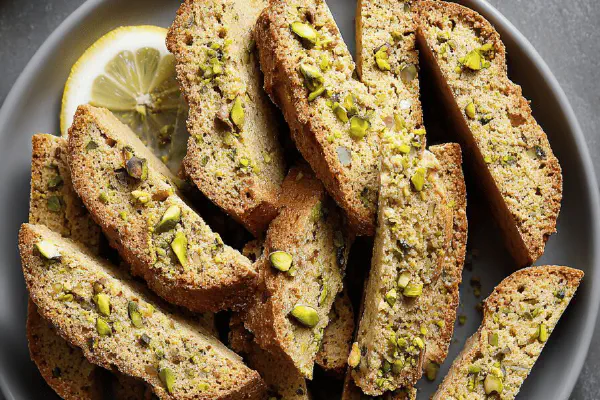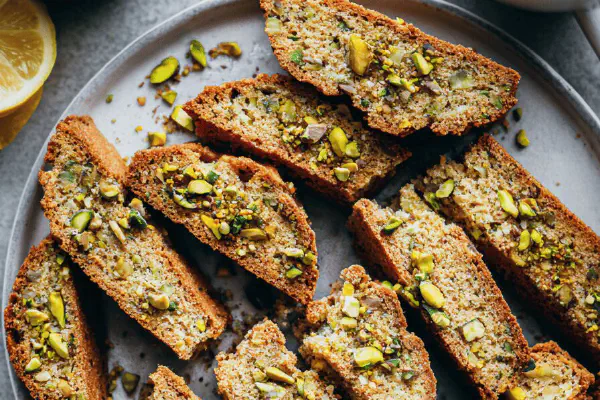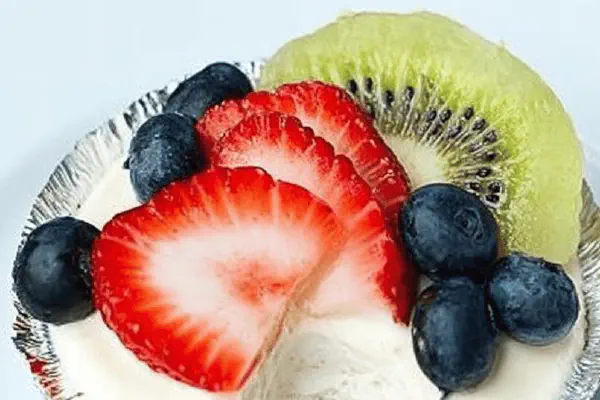Vegan Pistachio Lemon Biscotti

By Emma
Certified Culinary Professional
Ingredients
- 180 g (1 1/4 cups) unbleached all-purpose flour
- 95 g (1/2 cup) granulated sugar
- 6 ml (1 1/4 tsp) baking powder
- 70 g (1/2 cup) roasted, shelled pistachios
- 130 ml (1/2 cup) almond coffee creamer substitute
- 60 ml (1/4 cup) neutral vegetable oil
- 1 lemon, finely grated zest
About the ingredients
Method
- Preheat oven to 180 C (350 F). Place rack center. Line baking sheet with parchment or silicone mat.
- In mixing bowl, whisk flour, sugar, baking powder, and toasted pistachios together.
- Add almond coffee creamer, oil, lemon zest. Mix with hands lightly floured until dough comes together. Avoid overworking—dense tough biscotti no good.
- Shape dough into rough rectangle about 30 cm by 10 cm on baking tray. Pat gently. Should be slightly thick, not flat like cookie.
- Bake 28 to 33 minutes. Corners turn light golden. Test with toothpick; should come out mostly clean but moist crumbs cling.
- Remove and cool on wire rack 5 minutes. Transfer to counter, cool 10 more.
- Using serrated bread knife, slice loaf diagonally into 1 cm (1/2 inch) thick pieces. Keep slices neat—ragged edges burn faster.
- Arrange slices flat on baking trays so air can circulate. Bake at same temp 14 to 18 minutes, flipping halfway.
- Look for golden edges, firm dryness. Should snap when bent but not burn dark brown. Let cool fully on rack before storing.
- Store airtight—too long exposed and biscotti lose crunch or pick humidity.
Cooking tips
Chef's notes
- 💡 Start with preheating oven well—180 C steady heat matters for rise and color. Use parchment or silicone to avoid sticking or dark bottoms. Toast pistachios coarse for crunch; raw nuts dull texture and flavor. Dough should feel tacky not sticky—if too wet dust flour very lightly, better than overworking. Shape rectangle thick enough or loaf slumps flat. Slice with serrated knife slow, steady; ragged cuts burn easy. Flip slices halfway during second bake; watch last minutes close for browning then smoke starts. Cool completely on wire rack; warm slices go gummy fast.
- 💡 Mix dry ingredients first then add liquids carefully. Almond coffee creamer works better than oat in moisture retention; vanilla flavored if you want aroma but avoid overpowering. Neutral oil helps tenderness without taste; skip olive oil — flavor too strong. Zest fresh lemon finely grated gives bright punch, dried zest dulls brightness. Sugar reduced slightly from usual for better zing balance and less cloying. Baking powder only for leavening here not soda. Precise liquid measurements prevent dough spreading. Keep dough handling minimal, avoid tough biscotti from overmix or overly wet dough.
- 💡 Bake first batch 28 to 33 minutes till loaf edges light golden and toothpick test mostly clean but moist crumbs cling. Overbaking loaf dry crumb, tough slices later. Rest loaf 10-15 minutes on counter then slice diagonally about 1 cm thick. Thicker slices don't toast evenly and burn edges faster. Arrange slices spaced flat on trays air circulation key. Second bake shorter, 14 to 18 minutes flipping halfway. Early flip prevents scorch spots. Listen for snap test, smell nutty citrus aroma from zest and roasted nuts for doneness. Browning too dark means burnt and bitter taste.
- 💡 If pistachios unavailable swap toasted walnuts but expect flavor shift, less punch. Brown sugar changes texture too soft, so granulated sugar recommended. Bleached flour can weaken crumb; all-purpose unbleached best for bite. Measure precisely — liquid excess leads to spreading loaf during first bake. Cool completely before storing airtight container to keep crunch; exposure to air lets humidity soften biscotti rapidly. Two trays in two batches save time but keep oven temp stable. Resting between bakes critical for crumb integrity; slice while warm causes crumbling issues.
- 💡 Watch changes aroma and color—not just timer. Raw flour smell fades, replaced by nutty citrus, hot sugar caramelizing edges. Corners lighten first. Slice toast phase demands attention last 5 minutes; quick browning can go from golden to burnt rapidly. Flip fast to avoid dark spots. Light golden edges snap but not blacken. Use serrated bread knife slow cuts; jagged slices burn earlier. Keep slices spaced flat for even heat. Cool on wire rack fully. Store sealed tightly—biscotti absorb air and lose crisp texture. Avoid skipping zest it is bright spark in flavor here.
Common questions
Can I substitute pistachios?
Yeah, toasted walnuts work but taste less vibrant. Raw nuts no good, oily and bland. Different texture too. Toasting nuts important for crunch plus nutty aroma. Match chopping size with pistachios to keep overall texture consistent.
What if dough is sticky?
Too wet means add flour lightly. Hands flour-dusted helps feel dough texture—should be tacky not sticky. Overworking makes biscotti tough. Measure liquids precise. If too sticky, crumb structure weakens or spread loaf. Better add sparingly then judge than rush with more flour.
How to tell when biscotti are done baking?
Look for color changes first—edges golden, not brown or black. Smell shifts raw flour to nutty citrus and toasted nuts. Toothpick test: mostly clean with moist crumbs but no gooey batter. Snap test on toast slices. Watch closely second bake last minutes; slices brown quickly then smoke.
How to store biscotti best?
Airtight container needed. Avoid moisture and air exposure—biscotti lose crunch fast otherwise. Cool completely before sealing or slices get gummy. Room temp okay; fridge no need but humidity risk. Can freeze in seal bags if longer storage. Bring back crisp in toaster if softened.



